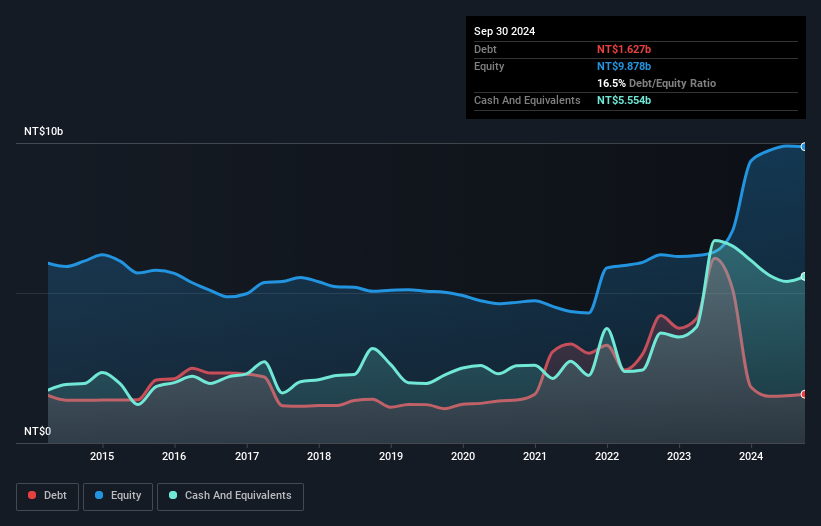Warren Buffett famously said, 'Volatility is far from synonymous with risk.' So it seems the smart money knows that debt - which is usually involved in bankruptcies - is a very important factor, when you assess how risky a company is. We can see that Phihong Technology Co., Ltd. (TWSE:2457) does use debt in its business. But the more important question is: how much risk is that debt creating?
What Risk Does Debt Bring?
Debt assists a business until the business has trouble paying it off, either with new capital or with free cash flow. Ultimately, if the company can't fulfill its legal obligations to repay debt, shareholders could walk away with nothing. However, a more common (but still painful) scenario is that it has to raise new equity capital at a low price, thus permanently diluting shareholders. Of course, the upside of debt is that it often represents cheap capital, especially when it replaces dilution in a company with the ability to reinvest at high rates of return. The first thing to do when considering how much debt a business uses is to look at its cash and debt together.
See our latest analysis for Phihong Technology
What Is Phihong Technology's Debt?
As you can see below, Phihong Technology had NT$1.63b of debt at September 2024, down from NT$5.10b a year prior. But on the other hand it also has NT$5.55b in cash, leading to a NT$3.93b net cash position.

How Healthy Is Phihong Technology's Balance Sheet?
Zooming in on the latest balance sheet data, we can see that Phihong Technology had liabilities of NT$4.48b due within 12 months and liabilities of NT$1.09b due beyond that. On the other hand, it had cash of NT$5.55b and NT$2.15b worth of receivables due within a year. So it actually has NT$2.14b more liquid assets than total liabilities.
This excess liquidity suggests that Phihong Technology is taking a careful approach to debt. Given it has easily adequate short term liquidity, we don't think it will have any issues with its lenders. Succinctly put, Phihong Technology boasts net cash, so it's fair to say it does not have a heavy debt load! The balance sheet is clearly the area to focus on when you are analysing debt. But it is Phihong Technology's earnings that will influence how the balance sheet holds up in the future. So if you're keen to discover more about its earnings, it might be worth checking out this graph of its long term earnings trend.
In the last year Phihong Technology had a loss before interest and tax, and actually shrunk its revenue by 18%, to NT$11b. We would much prefer see growth.
So How Risky Is Phihong Technology?
Although Phihong Technology had an earnings before interest and tax (EBIT) loss over the last twelve months, it made a statutory profit of NT$216m. So taking that on face value, and considering the cash, we don't think its very risky in the near term. We'll feel more comfortable with the stock once EBIT is positive, given the lacklustre revenue growth. When analysing debt levels, the balance sheet is the obvious place to start. However, not all investment risk resides within the balance sheet - far from it. To that end, you should be aware of the 1 warning sign we've spotted with Phihong Technology .
If you're interested in investing in businesses that can grow profits without the burden of debt, then check out this free list of growing businesses that have net cash on the balance sheet.
New: Manage All Your Stock Portfolios in One Place
We've created the ultimate portfolio companion for stock investors, and it's free.
• Connect an unlimited number of Portfolios and see your total in one currency
• Be alerted to new Warning Signs or Risks via email or mobile
• Track the Fair Value of your stocks
Have feedback on this article? Concerned about the content? Get in touch with us directly. Alternatively, email editorial-team (at) simplywallst.com.
This article by Simply Wall St is general in nature. We provide commentary based on historical data and analyst forecasts only using an unbiased methodology and our articles are not intended to be financial advice. It does not constitute a recommendation to buy or sell any stock, and does not take account of your objectives, or your financial situation. We aim to bring you long-term focused analysis driven by fundamental data. Note that our analysis may not factor in the latest price-sensitive company announcements or qualitative material. Simply Wall St has no position in any stocks mentioned.
About TWSE:2457
Mediocre balance sheet and slightly overvalued.
Similar Companies
Market Insights
Community Narratives




